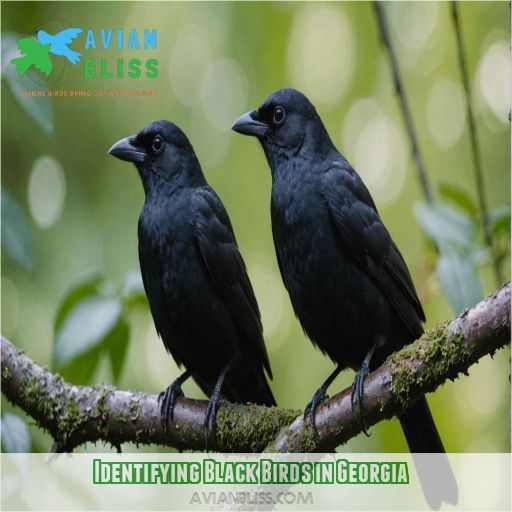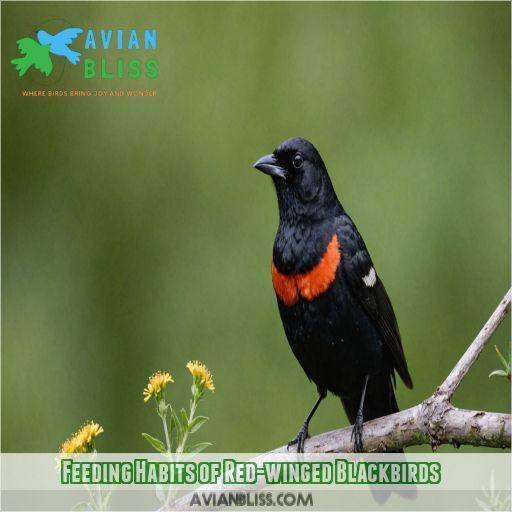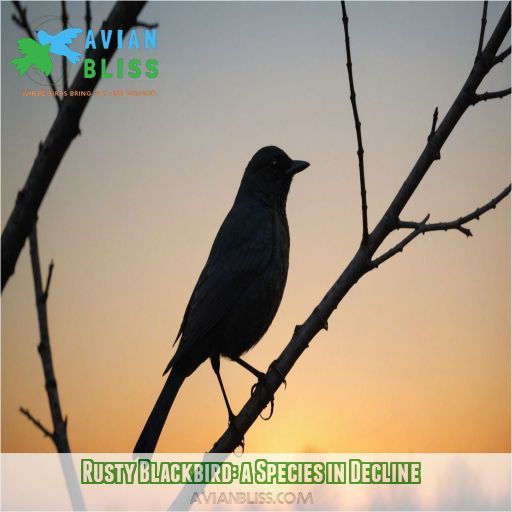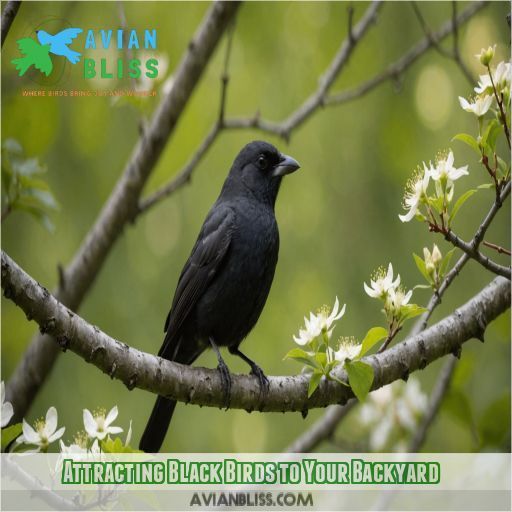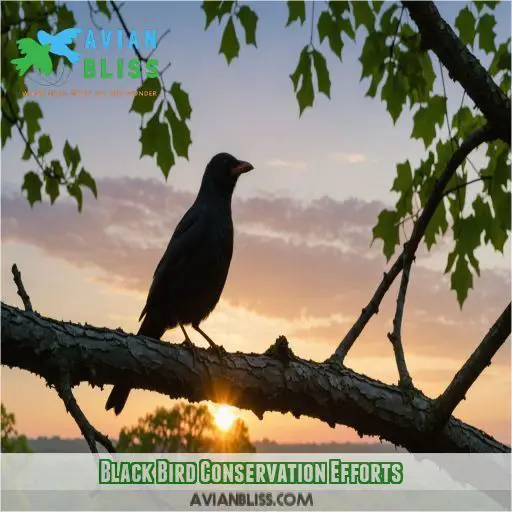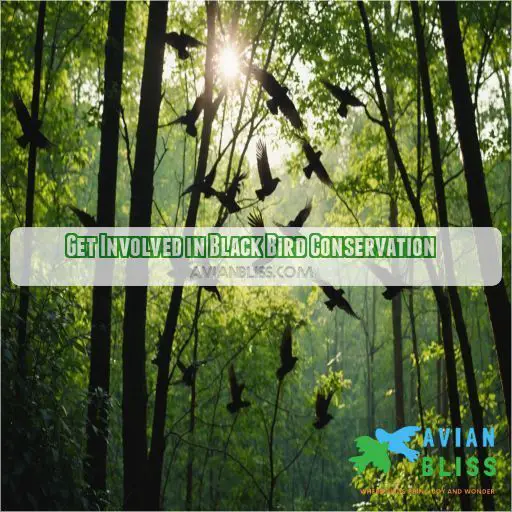This site is supported by our readers. We may earn a commission, at no cost to you, if you purchase through links.
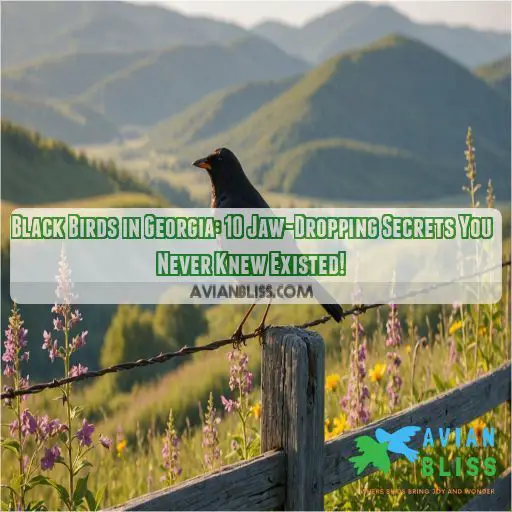
Let’s get into it.
You might be familiar with the Red-winged Blackbird, sporting its bright red and yellow shoulder patches, but did you know there are many more black bird species in the Peach State?
From the European Starling‘s iridescent sheen to the Brown-headed Cowbird‘s distinctive brown head, each bird has its unique charm.
As you explore the world of black birds in Georgia, you’ll discover their fascinating characteristics but also the important roles they play in the ecosystem – and that’s just the beginning!
Table Of Contents
- Key Takeaways
- Identifying Black Birds in Georgia
- Red-winged Blackbirds: a Georgia Icon
- Feeding Habits of Red-winged Blackbirds
- Rusty Blackbird: a Species in Decline
- Attracting Black Birds to Your Backyard
- Keeping Blackbirds Away From Your Feeders
- Black Bird Behavior and Migration
- Black Bird Conservation Efforts
- Black Birds in Georgia: Fun Facts
- Get Involved in Black Bird Conservation
- Frequently Asked Questions (FAQs)
- What is the black bird in Georgia?
- Are blackbirds good to have around?
- Are there crows or ravens in Georgia?
- What birds are usually all black?
- What percentage of Georgias bird population are black birds?
- Can black birds mimic other bird species or sounds?
- How long do black birds typically live in the wild?
- Are black birds known to form long-term monogamous relationships?
- What role do black birds play in pollination and seed dispersal?
- Conclusion
Key Takeaways
- Georgia’s black bird scene is a real showstopper, featuring stars like the Red-winged Blackbird, European Starling, and Brown-headed Cowbird – each with its own unique charm and fascinating characteristics that’ll keep you hooked.
- These birds are total team players, often forming long-term monogamous relationships, and some species even practice cooperative nesting behaviors – who knew they were such romantics?
- From the Red-winged Blackbird’s melodic songs to the European Starling’s impressive mimicry skills, these birds will keep you entertained – but beware, they can be a bit feisty when it comes to defending their territory or snagging food from your backyard feeder.
- By making a few simple changes to your outdoor space, you can entice these stunning birds to visit and stay a while, giving you a front-row seat to their fascinating behaviors and songs – so, grab some sunflower seeds, and let the bird-tastic show begin!
Identifying Black Birds in Georgia
You’re about to enter the fascinating world of black birds in Georgia.
The distinctive calls and vibrant plumage of species like the Red-winged Blackbird and European Starling will captivate your senses.
As you explore the Peach State’s diverse landscapes, you’ll discover the unique characteristics of each black bird species.
From the Brown-headed Cowbird’s brood parasitism to the Rusty Blackbird’s distinctive rusty-brown coloration, there’s a lot to discover.
Red-winged Blackbird Characteristics
When spotting black birds in Georgia, you might wonder what makes the Red-winged Blackbird so unique. Take a closer look:
- Distinctive Plumage: Males have a glossy black body with a bright red and yellow patch on their shoulders.
- Habitat Flexibility: They thrive in marshes, fields, and woodlands.
- Melodic Songs: Their loud, musical "conk-la-ree!" is a treat for the ears.
European Starling Features
You’re ready to meet the European Starling. With its glossy plumage and mesmerizing murmurations, this bird is a stunner. But, did you know they’re expert mimics too? Check out their fascinating features below:
| Characteristic | Description | Identification Tip |
|---|---|---|
| Plumage | Glossy black with purple tint | Look for a "purple sheen" |
| Mimicry | Can mimic other birds and sounds | Listen for varied songs |
| Murmurations | Create dazzling aerial displays | Watch for synchronized flying |
| Diet | Omnivorous, including insects and fruit | Offer mealworms or suet |
| Size | Approximately 8-10 inches long | Compare to American Robin size |
Brown-headed Cowbird Traits
The brown-headed cowbird is a stocky blackbird with a thick, conical bill. Males have jet-black bodies with a distinctive brown head, while females are a plain brown color with slight streaking. These fascinating birds are known as "brood parasites," laying their eggs in the nests of other species. Keep an eye out for their unique behaviors!
Other Black Bird Species in Georgia
As you explore Georgia’s black bird scene, you’ll discover more than just Red-winged Blackbirds. You’ll meet the European Starling, with its mesmerizing flock formations, and the Brown-headed Cowbird, infamous for laying eggs in other birds’ nests. But that’s not all – Georgia’s got a whole crew of fascinating black birds just waiting to be spotted.
- 3 more black birds to look out for in Georgia:
- Downy Woodpecker: a common visitor to backyard bird feeders with its signature black and white stripes.
- Dark-eyed Junco: a "snowbird" with a distinctive white tail flash and smooth greyish-black feathers.
- Rusty Blackbird: a medium-sized songbird with a distinctive rusty-brown color and a long, slender bill.
Red-winged Blackbirds: a Georgia Icon
As you explore the fascinating world of black birds in Georgia, you’ll quickly discover that Red-winged Blackbirds are a true Georgia icon, with their striking red and yellow shoulder patches making them a stunning sight to behold. These birds are a clear sign of Georgia’s rich biodiversity, playing a big role in the ecosystem by consuming insects and seeds, and their melodic songs will leave you enchanted .
Native Habitat and Diet
As you explore Georgia’s great outdoors, you’ll discover that Red-winged Blackbirds call this place home. Their native habitat includes marshes, fields, and woodlands, where they feast on insects, seeds, and fruits. Let’s take a closer look at their diet and habitat preferences:
| Season | Food Sources | Habitat | Interesting Fact |
|---|---|---|---|
| Breeding | Insects, aquatic plants | Marshes, flooded fields | Known for their distinctive call |
| Summer | Insects, seeds, fruits | grasslands, farm fields | Roost in large flocks |
| Fall | Seeds, grains, berries | Fields, pastures | Migrate in large numbers |
| Winter | Insects, seeds, suet | Woodlands, backyards | Visit bird feeders frequently |
Melodic Songs and Ecosystem Role
Red-winged Blackbirds are pretty amazing, right? You’ll hear their songs, a mix of sounds they call "conk-la-ree."
They’re really important for the environment.
Red-winged Blackbirds help keep insect populations in check and spread seeds, which helps nature stay healthy.
They’re a big part of Georgia’s biodiversity, which means they play a key role in keeping things balanced.
Symbol of Biodiversity and Interconnectedness
In Georgia’s ecosystems, red-winged blackbirds embody biodiversity and interconnectedness. Their presence highlights the intricate relationships between habitats, food webs, and species like the black vulture, American crow, boat-tailed grackle, and brown-headed cowbird. By understanding their role, you can grasp the bigger picture of conservation impact and appreciate the beauty of Georgia’s diverse ecosystems.
Feeding Habits of Red-winged Blackbirds
As you explore the fascinating world of black birds in Georgia, you’ll discover that Red-winged Blackbirds are quite the opportunistic feeders, consuming everything from seeds and insects to fruits and grains. Their feeding habits can be a delight to watch, but also a nuisance to homeowners who find their bird feeders constantly depleted by these birds’ voracious appetites .
Feeder Frenzy and Competition
You’re trying to enjoy a quiet morning with your bird feeder, but those pesky Red-winged Blackbirds are taking over! They’re notorious for their feeder frenzy and competition. Here are a few secrets to help you outsmart them:
- Switch to nyjer seed: Blackbirds aren’t fans of this tiny seed, but finches love it!
- Try safflower seed: Another blackbird-busting option that’s a hit with other birds.
- Invest in squirrel-proof feeders: These clever designs can outwit blackbirds too.
- Offer multiple feeders: Spread the love (and the food) to reduce competition.
Nuisance to Homeowners and Seasonal Shift
You’re frustrated with those pesky red-winged blackbirds taking over your feeder. Don’t worry, friend, you’re not alone! As breeding season approaches, they shift to a diet of insects and wild foods, reducing their feeder frenzy. Here’s a handy guide to help you cope:
| Season | Diet | Feeder Activity | Backyard Solutions |
|---|---|---|---|
| Winter | Seeds, fruits | High | Offer alternative foods like suet, nuts |
| Spring | Insects, wild foods | Low | Use bird feeder designs with weight-activated perches |
| Summer | Insects, seeds | Medium | Try cage-like feeders or netting to exclude blackbirds |
| Fall | Seeds, fruits | High | Plant native vegetation or offer sunflower seeds |
Opportunistic Feeders and Dietary Variation
You’re probably no stranger to the feeder frenzy caused by red-winged blackbirds. As opportunistic feeders, they chow down on a variety of food sources, adapting to seasonal changes and human impact. Here are 3 surprising things they love to munch on:
- Insects: Juicy bugs are a staple in their diet, providing essential protein.
- Seeds: Sunflower seeds and cracked corn are favorites, especially during winter months.
- Fruits: Suet and fruits like berries are also on the menu, making them quite the foodies.
Rusty Blackbird: a Species in Decline
When you’re exploring birds in Georgia, you’ll encounter the Rusty Blackbird, a species whose numbers are alarmingly dwindling. Let’s take a closer look at this medium-sized songbird, whose distinctive rusty-brown color and long, slender bill make it a standout, but also a species in dire need of conservation efforts.
Identification and Habitat Preferences
To spot a Rusty Blackbird, look for a medium-sized songbird with a distinctive rusty-brown color during breeding season. You can also identify them by their black head, neck, and wings, paired with a long, slender bill. Here’s a quick guide to Rusty Blackbird identification and habitat preferences:
| Characteristics | Description |
|---|---|
| Breeding Season | Rusty-brown color, black head, neck, and wings |
| Winter Months | Grayish-brown coloration, similar to other blackbirds |
| Habitat | Wet meadows, marshes, and bogs with dense vegetation |
| Nesting | Trees or shrubs with abundant insects and invertebrates |
| Migration | Seasonal migration between breeding and wintering habitats |
Now you know what to look for!
Diet and Foraging Habits
If you’re looking at what a Rusty Blackbird eats, you’ll likely see they prefer insects over seeds. These birds forage on the ground, in trees, and in shrubs, snatching up spiders and other invertebrates with ease. As the seasons change, so does their diet – they’ll eat more seeds and fruits during winter months when insects are scarce.
Population Trends and Conservation Efforts
Let’s talk about the Rusty Blackbird, a species in decline. You might be surprised to learn that their population has been plummeting due to habitat loss and climate change. To combat this, conservation efforts are underway, including Citizen Science projects and research initiatives. Your support can make a difference in protecting these amazing birds and their habitats.
Attracting Black Birds to Your Backyard
You’re probably excited to attract some amazing black birds to your Georgia backyard, but you might be wondering where to start. By making a few simple changes to your outdoor space, you can entice these stunning birds to visit and stay awhile, giving you a front-row seat to their fascinating behaviors and songs.
Top Backyard Birds to See in Georgia
Now that we’ve covered the Rusty Blackbird, let’s talk about attracting some amazing birds to your backyard! In Georgia, you can spot stunning species like the Red-winged Blackbird, European Starling, and Brown-headed Cowbird. To entice them, use bird feeders with sunflower seeds, suet, and peanuts. Keep your feeders clean and well-stocked for a bird-tastic show!
Northern Mockingbird and White-breasted Nuthatch
As you welcome black birds to your backyard, keep an eye out for the Northern Mockingbird and White-breasted Nuthatch. The Mockingbird’s melodic songs will serenade you, while the Nuthatch’s agile antics will entertain. Both are common visitors, with the Mockingbird’s nesting habits and the Nuthatch’s winter survival strategies making them fascinating additions to your bird-watching adventures.
Song Sparrow and American Goldfinch
Now that you’ve attracted Northern Mockingbirds and White-breasted Nuthatches to your backyard, let’s talk about two more visitors you might enjoy: Song Sparrows and American Goldfinches! These birds love seeds and insects, so offer sunflower seeds and Nyjer seeds in your feeders. Keep your backyard birdbath clean and filled, and they’ll be singing sweet melodies in no time!
Red-bellied Woodpecker and Other Visitors
As you welcome song sparrows and American goldfinches to your backyard, don’t be surprised if red-bellied woodpeckers join the party! These woodpeckers love suet, sunflower seeds, and peanuts, and their distinctive "querrr" calls will entertain you. By offering their favorite treats and maintaining dead trees for drumming, you’ll attract these stunning woodpeckers and add to the backyard fun.
Keeping Blackbirds Away From Your Feeders
You love watching the birds visit your feeder, but those blackbirds can be quite the bullies, chasing away the smaller birds and hogging all the food. Don’t worry, we’ve got some simple and effective tips to help you keep those blackbirds at bay and make your feeder a more welcoming spot for all the birds you love.
Change Up Your Food Offering
Want to keep those blackbirds from taking over your feeder? Change up your food offering! Switch from seed to suet or high-energy treats like peanuts or mealworms. Blackbirds tend to shy away from these pricier options. Consider using blackbird-proof feeders or offering natural food sources like thistle seed. Maintenance and cleaning can also make a big difference!
Alternative Feeding Methods
To outsmart those clever blackbirds, try alternative feeding methods! Use platform feeders or hanging baskets that allow smaller birds to feed comfortably. Get creative with DIY feeders, and offer varied seed mixes and suet cakes. Experiment with different bird feeder placement, location, height, size, and materials to find the perfect combination that keeps blackbirds at bay.
Using Bird Repellents and Deterrents
Now that you’ve changed up your food offering and tried alternative feeding methods, it’s time to think about bird repellents and deterrents! From visual scarecrows to noise-making devices, there are many types to choose from. DIY deterrents like shiny reflective tape or predator decoys can also be effective. Just remember to prioritize repellent safety and think about ethical concerns.
Black Bird Behavior and Migration
When you’re exploring black birds in Georgia, you’ll discover fascinating behaviors and migration patterns that showcase their adaptability and social nature. From the flocking habits of red-winged blackbirds to the seasonal migrations of rusty blackbirds, understanding these behaviors will help you better appreciate the complex lives of these incredible birds.
Flock Behavior and Social Nature
As you gaze up at the mesmerizing flock formations of black birds, you’re witnessing a remarkable social network in action!
With complex communication methods, a strict social hierarchy, and even cooperative nesting behaviors, these birds are truly the ultimate team players.
Just ask the turkey vulture, blue jay, or double-crested cormorant – they’ve learned to coexist with these sleek, mysterious creatures.
Breeding Habitat and Seasonal Migration
You’re curious about the secret lives of Georgia’s black birds. During breeding season, they flock to wetlands, marshes, and open fields, seeking the perfect spot to build their nests. As the seasons change, they migrate to their wintering grounds, flying thousands of miles each year. Their habitat preferences are key to their seasonal migration patterns within the state.
Winter Visitors and Springtime Rituals
As winter visitors to Georgia, black birds like the ruby-crowned kinglet and tree swallow bring excitement to your backyard.
Come spring, their morning songs are music to your ears.
But have you ever wondered about their nesting habits or migration patterns?
A bird identification expert can help you learn more through training and learning programs, revealing secrets of their food sources and behavior.
Black Bird Conservation Efforts
As you learn about the fascinating world of black birds in Georgia, you’ll discover the importance of conservation efforts in protecting these amazing species. By getting involved in habitat restoration, public education, and citizen science projects, you can play a big part in preserving the natural beauty and biodiversity of Georgia’s black bird populations.
Habitat Restoration and Protection
As you explore Georgia’s black bird habitats, you’ll want to support habitat restoration and protection efforts. Organizations like the Harris Neck National Wildlife Refuge work tirelessly to restore wetlands, promote native planting, and reduce pesticide use. By getting involved in citizen science projects and advocating for bird-friendly policies, you can help safeguard these magnificent creatures’ homes.
Public Education and Awareness
You’re a big part of blackbird conservation! By spreading awareness, you can make a real difference. Share your passion with friends and family, and watch the ripple effect. Here are some ways to get started:
- Host a backyard bird-watching party and share blackbird myths and facts.
- Build a bird-friendly DIY feeder and share the plans with neighbors.
- Create a social media challenge to ID blackbirds and share conservation impact.
- Partner with local schools to integrate bird conservation into their curriculum.
Citizen Science Projects and Research
You can make a real difference in Black Bird conservation by participating in citizen science projects! By collecting data on population sizes, habitats, and behaviors, you’ll help researchers understand the Rusty Blackbird decline. Join projects like eBird, HawkWatch, or volunteer at Georgia’s national parks like Kennesaw Mountain, Jekyll Island, or Sapelo Island.
| Project | Location |
|---|---|
| eBird | Statewide |
| HawkWatch | Fort Mountain State Park |
| Rusty Blackbird Survey | Saint Catherines Island |
Black Birds in Georgia: Fun Facts
As you explore the fascinating world of black birds in Georgia, you’ll discover some truly remarkable fun facts that will leave you amazed. From their unique characteristics and behaviors to myth-busting trivia, get ready to learn some jaw-dropping secrets that will make you appreciate these incredible birds even more.
Interesting Black Bird Behaviors
You’re in for a treat when it comes to black bird behaviors in Georgia! Watch as Red-winged Blackbirds perform their elaborate mating rituals, complete with song and dance. Meanwhile, European Starlings are masters of communication, mimicking over 20 different bird species. And when it’s time for flight, these birds are pros, migrating thousands of miles each year.
Unique Characteristics and Adaptations
As you explore the fascinating world of black birds in Georgia, you’ll notice their unique characteristics and adaptations. The Brown-headed Cowbird‘s mimicry skills, for example, help it learn songs from other birds. Meanwhile, the Red-winged Blackbird‘s nesting strategies involve building intricate cup nests. Understanding these traits will give you a deeper appreciation for these remarkable birds.
Black Bird Myth-Busting and Trivia
- European Starlings aren’t from Europe (originally) – They’re native to Asia and were introduced to Europe by the Romans.
- Cowbirds aren’t lazy – They just have a unique parenting strategy, letting others raise their young.
- Blackbirds are intelligent – Some species use tools to gather food and outsmart predators!
Get Involved in Black Bird Conservation
You’re now equipped with a wealth of knowledge about black birds in Georgia, but what’s next? By getting involved in black bird conservation, you’ll be helping these amazing creatures, and you’ll also be joining a community of like-minded folks who share your passion for nature and wildlife preservation.
Supporting Conservation Organizations
You want to support conservation organizations that help protect Georgia’s amazing black birds. Your donation can have a real impact, from restoring habitats to funding research. Look for advocacy groups that align with your values and offer volunteer opportunities. Even small actions can add up to make a big difference for these incredible birds.
Participating in Citizen Science Projects
- 1. eBird: Share your bird sightings and help researchers track bird populations.
- 2. Project FeederWatch: Monitor your backyard bird feeders and submit data on the birds that visit.
- 3. NestWatch: Help study bird breeding habits by monitoring nests in your area.
Spreading Awareness and Educating Others
You’re a blackbird enthusiast now! Share your passion with others by spreading awareness about these amazing birds. Organize local outreach programs, bird-watching tours, or simply share your favorite bird ID guide with friends. By inspiring others to care about blackbird conservation, you’ll create a ripple effect that fosters backyard biodiversity and supports citizen science initiatives.
Frequently Asked Questions (FAQs)
What is the black bird in Georgia?
You’re wondering about the black bird in Georgia? Well, you’re in luck because the state is home to several species, including the Red-winged Blackbird, European Starling, and Brown-headed Cowbird, each with unique characteristics .
Are blackbirds good to have around?
Having blackbirds around is a ‘bird-brained’ blessing in disguise! They play a key role in controlling insect populations, which can reduce damage to your garden. Plus, their songs add a delightful symphony to your neighborhood.
Are there crows or ravens in Georgia?
You’re looking for crows or ravens in Georgia . While American Crows are common, Common Ravens are rare in the state, with limited sightings in the high elevations of northern Georgia .
What birds are usually all black?
You’re wondering about all-black birds? Well, you’re likely thinking of European Starlings, which have a glossy black plumage, or Red-winged Blackbirds, whose males are all black with a distinctive red and yellow patch on their shoulders.
What percentage of Georgias bird population are black birds?
Don’t worry, you’re not alone in wondering about black birds in your backyard. In fact, black birds make up around 10-15% of Georgia’s bird population, so you’re likely to spot some, like the Red-winged Blackbird or European Starling!
Can black birds mimic other bird species or sounds?
You might be surprised to know that some black birds, like the European Starling, can mimic other bird species or sounds . However, not all black bird species possess this unique ability, including the Red-winged Blackbird.
How long do black birds typically live in the wild?
You’re wondering how long black birds live in the wild? Coincidentally, their lifespan mirrors our desire for freedom and flexibility! Typically, black birds live 2-5 years in the wild, but some species can thrive up to 10 years.
Are black birds known to form long-term monogamous relationships?
You might be surprised, but some black birds are known to form long-term monogamous relationships! In fact, Red-winged Blackbirds, a common species, are often seen with a single mate for several breeding seasons, showing remarkable fidelity.
What role do black birds play in pollination and seed dispersal?
Being the ‘unsung heroes’ of ecosystems, you’ll be delighted to know that black birds play a big role in pollination and seed dispersal, transporting seeds and pollen on their beaks, feathers, and feet, fostering new plant growth.
Conclusion
Are you ready to become a black bird expert in Georgia?
You’ve probably noticed there’s a lot going on with black birds in Georgia, from the Red-winged Blackbird’s distinctive songs to the Rusty Blackbird’s unfortunate decline.
By learning more about these birds and their habits, you’ll appreciate their beauty but also help protect them.

